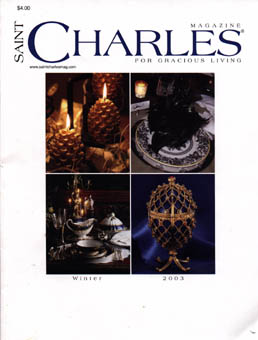

 |
 |
 FESTIVE HOLIDAY TABLE SETTINGS
FESTIVE HOLIDAY TABLE SETTINGS
TABLETOP DESIGNS FOR HOME ENTERTAINING
by Kaya Morgan
Exquisite and colorful, perfectly matched or eclectically mixed, festive table settings are especially appropriate this time of year. No matter how perfectly you have planned every detail of your holiday celebration, everything you serve will be more appealing if you set your holiday table to suit the occasion.
After all, this is the season when we open our homes to family and friends, co-workers and neighbors, not to mention those guests who drop by unexpectedly. For some of us who are fortunate enough to have inherited collections, it is time to polish the antique silverware, sterling flatware — including the ivory-handled knives — and the fine porcelain set we use on holidays and special occasions.
 In modern homes from Europe and the Baltic Region to the Americas and Pacific Islands, Singapore and Hong Kong, planning and preparation for holiday dinners, lunches and buffets begins sometime before Thanksgiving and continues through New Year's day.
In modern homes from Europe and the Baltic Region to the Americas and Pacific Islands, Singapore and Hong Kong, planning and preparation for holiday dinners, lunches and buffets begins sometime before Thanksgiving and continues through New Year's day.
Setting the table has not always been a complicated task. The spoon and knife have been around since the Bronze Age, but a two-prong fork, which was introduced in Venice by the wife of a doge (chief magistrate) in the eleventh century, was not in common use in most of Europe until the end of the seventeenth century. Men who used a fork — widely regarded an Italian oddity — instead of the "proper three fingers" were considered ill-mannered or effeminate. Two-prong forks evolved into four-prong designs over the centuries, and teaspoons, dessert forks and fish eaters (named for their distinct functions) eventually followed.
 Until the end of the nineteenth century, even the finest silver flatware services rarely included matching table knives. Instead, those were usually sharply pointed steel blades with handles of ivory, bone and iron or wood. Legend says Cardinal Richelieu, the French ecclesiastic and statesman known for meticulous manners, introduced the blunt shape of table knives in the sixteenth century, after having become disgusted with his noble dinner guests using their knives to clean their teeth at the dinner table!
Until the end of the nineteenth century, even the finest silver flatware services rarely included matching table knives. Instead, those were usually sharply pointed steel blades with handles of ivory, bone and iron or wood. Legend says Cardinal Richelieu, the French ecclesiastic and statesman known for meticulous manners, introduced the blunt shape of table knives in the sixteenth century, after having become disgusted with his noble dinner guests using their knives to clean their teeth at the dinner table!
When it comes to the all-important details of careful menu planning, it is a good idea to write down everything from the number of guest and their names (for personalized name cards) to special dietary requirements for diabetics or vegetarians. Seating arrangements can be sketched out in advance, and as the host or hostess, you can arrange your guests around the table to avoid conflicts or to play matchmaker with single guests which can be great fun — should you so choose.
 If you have ample space in your home, and depending on the size of your dinner party, a good idea may be to serve your Holiday dinner courses in different rooms. For example, why not offer cocktails and appetizers in the living room, library, den or pool deck? Then, set up the place settings of small platters, cocktail napkins (cloth if you wish to keep a formal feeling), and salad forks around hot and cold hors d'oeuvres with plenty of serving pieces or finger foods already neatly pierced with toothpicks.
If you have ample space in your home, and depending on the size of your dinner party, a good idea may be to serve your Holiday dinner courses in different rooms. For example, why not offer cocktails and appetizers in the living room, library, den or pool deck? Then, set up the place settings of small platters, cocktail napkins (cloth if you wish to keep a formal feeling), and salad forks around hot and cold hors d'oeuvres with plenty of serving pieces or finger foods already neatly pierced with toothpicks.
Serve the main course at the formal dining table, set in all its glory with fine linen tablecloth, napkins, candelabras, soup tureens, your best porcelain or stoneware, matched or mixed flatware in gold plate or silver, and goblets of glass or crystal. Think of the holiday table as the canvas on which you are creating an elegant work of art! However, try not to crowd your dinner guests with so many plates that there is no room for dining in comfort.
 When serving salads, you can place individual servings on the table before guests are seated, but keep the dressings on the side. It's also appropriate to fill water goblets about three-fourths full ahead of time, perhaps with small ice cubes or cracked ice to keep it fresh and cold. Keep a water pitcher on the table or on a nearby buffet cabinet. Soup should be served at the table, hot from the tureen, but never before the guests take their seats at the table. Warm rolls or freshly-baked breads should be served with the salad, and again with the soup and main course.
When serving salads, you can place individual servings on the table before guests are seated, but keep the dressings on the side. It's also appropriate to fill water goblets about three-fourths full ahead of time, perhaps with small ice cubes or cracked ice to keep it fresh and cold. Keep a water pitcher on the table or on a nearby buffet cabinet. Soup should be served at the table, hot from the tureen, but never before the guests take their seats at the table. Warm rolls or freshly-baked breads should be served with the salad, and again with the soup and main course.
After the main course, take your guests to yet another venue — the family room or garden patio — for desert and coffee, and perhaps an after-dinner brandy or eggnog. There are several advantages to serving the courses in three distinct areas in your home. Firstly, it becomes possible to set up the appropriate place settings on different tabletops, thereby, not crowding everything onto one table. Another great advantage is that you can use stoneware, china, porcelain, or faience of different patters at each venue, sparing your guest the monotony of a single color scheme and allowing you to experiment with your limitless imagination and creativity. Finally, getting your guests to move from one place to another is actually better for healthy digestion, while it allows you and your helpers to clear the dinner table more quickly — not to mention more fun by allowing you to change seating arrangements easily.
 It's a good idea to practice setting your main dining table, as well as appetizer and dessert layouts, before the big event. This will help to determine ahead of time if you need to rethink your plan in order to make more room at the main dining table. Bulky candelabras may have to be moved to the piano top and replaced by a pair of slender tapers or individual small candles. A centerpiece may have to find a place on the mantel. Or, you may decide to have six instead of eight side chairs to allow for more elbow room. Always plan for the unexpected — one or two additional guests could otherwise throw your plans in to chaos — so be flexible.
It's a good idea to practice setting your main dining table, as well as appetizer and dessert layouts, before the big event. This will help to determine ahead of time if you need to rethink your plan in order to make more room at the main dining table. Bulky candelabras may have to be moved to the piano top and replaced by a pair of slender tapers or individual small candles. A centerpiece may have to find a place on the mantel. Or, you may decide to have six instead of eight side chairs to allow for more elbow room. Always plan for the unexpected — one or two additional guests could otherwise throw your plans in to chaos — so be flexible.
But how many forks at each place setting, how many knives, and what goes where? Generally speaking, it is most acceptable to have both a dinner fork and smaller salad fork placed on the left side of the dinner plate, with the knife and teaspoon on the right side. An additional fork or a soup spoon can be added to the place setting if dessert and soup are being served. Silverware can also be rolled up in a napkin and placed across the plate informally, or tied with a ribbon and fanned out.
 If formal isn't your style, try a buffet setting for a much more casual atmosphere. Sturdy stoneware would be recommended. But it's a good idea to keep the napkins and silverware wrapped together or placed at the diner table with the water goblets, thereby avoiding most dropping and spilling accidents. And if you love using napkin rings, by all means do so, but be prepared to lose one or two with any large gathering. Some hosts prefer to neatly fold napkins on or besides the dinner plates in a favorite design.
If formal isn't your style, try a buffet setting for a much more casual atmosphere. Sturdy stoneware would be recommended. But it's a good idea to keep the napkins and silverware wrapped together or placed at the diner table with the water goblets, thereby avoiding most dropping and spilling accidents. And if you love using napkin rings, by all means do so, but be prepared to lose one or two with any large gathering. Some hosts prefer to neatly fold napkins on or besides the dinner plates in a favorite design.
Whether you choose to dazzle your guests with expensive, hand-painted porcelain and designer cutlery, or create an artful arrangement of an eclectic mix of tabletop settings, putting that extra effort into the planning and creative design of your tabletop this season will add to the warmth and cheer of your holiday festivities.
For more information contact www.royalchina.com

All Rights Reserved © 2005
Press Coverage | VentureCapital | Business Development | Venture Opportunities | Resources | Contact Us | Investor Extras | Home